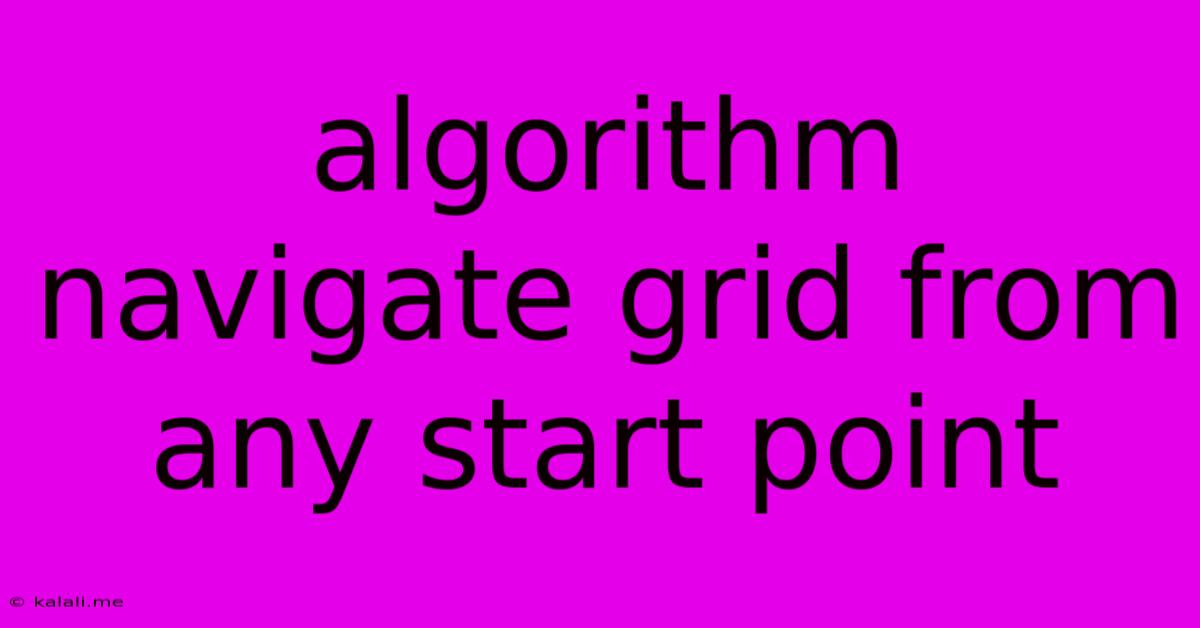Algorithm Navigate Grid From Any Start Point
Kalali
May 29, 2025 · 3 min read

Table of Contents
Algorithm to Navigate a Grid from Any Start Point
Finding the shortest path across a grid from a given starting point to a target destination is a classic computer science problem with applications ranging from robotics and game AI to network routing and pathfinding in GPS systems. This article will explore several algorithms capable of solving this, focusing on their strengths and weaknesses. We'll avoid complex implementations, focusing instead on the core concepts and strategies.
Understanding the Problem:
We're dealing with a grid, essentially a two-dimensional array, where each cell can be either traversable (e.g., open space) or blocked (e.g., a wall). The algorithm needs to find the shortest path from a specified starting cell to a specified target cell, avoiding obstacles.
Common Algorithms:
Several algorithms excel at navigating grids. Here are a few prominent examples:
1. Breadth-First Search (BFS):
BFS is a graph traversal algorithm that systematically explores the grid level by level. It guarantees finding the shortest path if one exists.
- How it works: BFS starts at the source node and explores all its neighbors. Then, it explores the neighbors of those neighbors, and so on, using a queue data structure to manage the order of exploration. It keeps track of the path taken to reach each cell.
- Strengths: Guaranteed to find the shortest path. Relatively simple to implement.
- Weaknesses: Can be computationally expensive for large grids.
2. Depth-First Search (DFS):
DFS explores the grid by going as deep as possible along each branch before backtracking. While simpler to implement recursively, it doesn't guarantee the shortest path.
- How it works: DFS uses a stack (implicitly through recursion or explicitly) to track the path. It explores one branch completely before moving to the next.
- Strengths: Simple implementation (recursive). Low memory overhead compared to BFS for some cases.
- Weaknesses: Doesn't guarantee the shortest path. Can get stuck in infinite loops in certain graph structures.
3. A* Search (A*):
A* is a more sophisticated algorithm that combines the best aspects of BFS and heuristics. It's widely used in game AI and pathfinding applications because of its efficiency.
- How it works: A* uses a heuristic function (an estimated cost to reach the target) to guide its search, prioritizing cells that appear closer to the target. It uses a priority queue to manage the order of exploration based on a cost function (f = g + h), where g is the cost to reach the current cell and h is the heuristic estimate.
- Strengths: Efficiently finds the shortest path. Handles large grids better than BFS.
- Weaknesses: The performance depends heavily on the choice of heuristic function. A poorly chosen heuristic can lead to suboptimal results. More complex to implement than BFS or DFS.
4. Dijkstra's Algorithm:
Dijkstra's algorithm is another popular choice, particularly useful when edge weights (costs) are involved. In our grid context, this might represent different traversal costs for different cells.
- How it works: Similar to A*, it uses a priority queue to manage the exploration, but it doesn't use a heuristic function. It iteratively explores the node with the smallest cost until the target is reached.
- Strengths: Finds the shortest path with weighted edges. Relatively efficient.
- Weaknesses: Doesn't incorporate heuristics, so it can be less efficient than A* in unweighted scenarios.
Choosing the Right Algorithm:
The best algorithm depends on the specific requirements:
- For simple grids and a guarantee of the shortest path, BFS is a good choice.
- For larger grids where efficiency is crucial, A* is often preferred.
- For grids with weighted edges, Dijkstra's Algorithm is suitable.
- DFS is generally less suitable for finding shortest paths due to its lack of guarantee.
This overview provides a foundation for understanding grid navigation algorithms. Further exploration into the implementation details and nuances of each algorithm will enhance your ability to apply them effectively in various applications. Remember to consider factors like grid size, the presence of obstacles, and the need for optimal path length when selecting an algorithm.
Latest Posts
Latest Posts
-
How To Size A Bike Wheel
May 31, 2025
-
Wiring On Off On Toggle Switch Diagram
May 31, 2025
-
Is Protection 1 Better Than Unbreaking 1
May 31, 2025
-
Lego Harry Potter 1 4 Codes Wii
May 31, 2025
-
How To Keep Birds From Flying Into My Windows
May 31, 2025
Related Post
Thank you for visiting our website which covers about Algorithm Navigate Grid From Any Start Point . We hope the information provided has been useful to you. Feel free to contact us if you have any questions or need further assistance. See you next time and don't miss to bookmark.